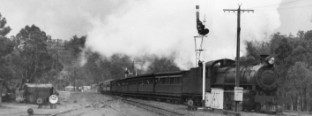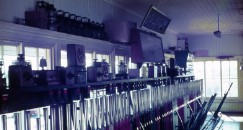Robb Jetty (2)
WAGR - Marshalling Yard | |
1938 WAGR MAP Mileage = 15 | |
Next Down Station: | Next Up Station: |
COCKBURN NORTH | |
Quick Facts | |
Opened | Closed |
27/02/1972 | 1994 |
Mechanical | Electrical |
- | Signal Panel |
Fate: Demolished | |
Announced by multiple page instructions in WAGR Weekly Notice No 6 of 1972, the final stage of the Commissioning of the Robb Jetty Standard and Narrow Gauge Signalling and Interlocking was formailsed. The Weekly Notice proclaimed:
"On Sunday, 27th February, 1972, in conjunction with the commissioning of the final stage of signalling at Robb Jetty the standard gauge section Cockburn North – Box ‘B’ Fremantle operated under the rules applicable to the automatic signalling system (single line) will be closed and the following sections substituted and brought into use:-
Box ‘B’ Fremantle - Robb Jetty,Robb Jetty - Cockburn North.On introduction of the aforementioned sections, signalling will then be in accordance with Diagram of Signalling Copy of C.C.E. Plan No. 59339F
Also on the same day:
"The existing signalling and interlocking at Robb Jetty will be taken out of use. At the same time, the Train Electric Staff system between Box ‘A’ Fremantle and Robb Jetty (narrow gauge) will be withdrawn. In addition the standard gauge single line section Box ‘B’ Fremantle - Cockburn North operated under the rules applicable to automatic signalling (single line), will be cancelled.
The existing signal box within the station building will be taken out of use, all control of the signalling and interlocking at Robb Jetty will be transferred to the new control tower where all signalling functions will be centred on an area signalling console under the control of area signalmen.
The existing semaphore signals controlling movements on the narrow gauge line in the station area including the two Switchlocks on the standard gauge main line giving access to the standard gauge yard at both ends will be taken out of use and removed.
On completion of the alterations and the introduction of the new signalling and interlocking, signalling at Robb Jetty will then be in accordance with Diagram of Signalling
The Robb Jetty Signalman worked trains between Cockburn North (inland), operated by the Signalman on the 'South West' panel of the Midland Signalling Centre (Midsig), and the Fremantle cabins, Fremantle Box 'A' for narrow gauge and Fremantle Box 'B' for standard gauge. The lines either side of Robb Jetty could have been regarded by the casual observer as double track main line, except that they were one of each gauge! Just to add interest, there was a diamond crossing just inside the yard at the Power House end which remained in place after the panel closed.
Unfortunately, the removal of the marshalling yards and introduction of Train Order working sounded the death-knell for the Robb Jetty Panel and the building was heavily vandalised just before being demolished.
The original narrow gauge line to Kwinana via Coogee, Woodman's Point (Munitions sidings) and Naval Base branched off at Robb Jetty. This line was worked in the latter days by Train Staff & Ticket working (Staff only), and was effectively severed when a massive floating oil-drilling platform was constructed near Woodman's Point. The sidings along this route, like Robb Jetty with its abattoirs, power station, potato depot and salt works, serviced a variety of industries.
The console in which the panel sections were set is believed to have been lost, but the five panel sections and all their 'innards' survive! The panel was fitted with miniature key-switches (like those used in telephone switchboards of the era). The signal switches were located 'geographically' on the panel diagram adjacent to representations of the signal they controlled, whilst point and switchlock release switches were mounted in a row along the bottom of the panel. For many years, there were separate Train Register Books for both gauges of trains, but as traffic frequency decreased, only one book was used. Oh, and yes, for those with sharp eyes - they are HOLDEN car ash trays built into the front of the panel!
In a possible effort to confuse novice operators, the telephone on the desk part of the console is actually a two-way radio! For some peculiar reason, the radio was fitted into a standard phone case, with a red 'transmit' button near the earpiece, and a volume control where the dial should have been. In addition to the earphone speaker, an extention speaker for the radio was placed under the console's desk. The radio was also fixed on the 'Robbs Radio Channel'. Leighton marshalling yard, shunted by Robb Jetty locos and staff (a daily occurrence, when traffic required) worked on a different radio channel. This meant that the Robb Jetty Signalman had to contact either Kwinana or Metro Control to get a message to them if need be, or to have them change channels if more detailed information was to be relayed. The microphone over the center of the panel was for the replying to the numerous yard telephones. Apart from a switch on the panel which the Signalman pressed when he wished to speak, a foot switch was also provided under the 'radio-phone' for this purpose. The yard phone speaker was behind the grille on the right hand end of the panel.
The Narrow Gauge line to Cockburn North was, (at the time of the photo above), under Train Electric Staff regulations. Railway Signal Company 'miniature' instruments were used, and, as the Narrow Gauge line crossed the Standard Gauge at Spearwood - junction for the Bibra Lake sidings (originally the branch line to Armadale via Jandakot), an Auxiliary Instrument was also provided at both Spearwood and Robb Jetty. The four instruments worked in the same circuit, (Editor's Note: Similar to the arrangement previously used at East Avon), so that only one Staff could be withdrawn from any of the instruments at any one time. The electric staff on the narrow gauge section was withdrawn when colour light signalling was finally installed on this line in 1982.
The view from the panel was always extraordinary! The Signalman however, did not always spend his time staring out of the window, as he worked the panel by facing away from the ocean. The yellow GE wagons seen in the photo at right were narrow gauge four wheelers awaiting scrapping. Hundreds of such wagons met their fate in the old power house coal sidings, being broken up and burnt by private contractors. Just out of shot to the left, were the two roads which formed the stock wagon wash-out. Apart from the narrow and standard gauge main lines, all these tracks were lifted and very rapidly 'rehabilitated' to give better public access to the beach.
One thing that became apparent when the yard was designed, was that the close proximity to the ocean, (and the shipping lanes), the lights from the signals could cause problems for ships using the nearby port of Fremantle. The signal lights might be mistaken for navigation lights and so had to be carefully 'sighted', and in some cases specially dimmed so that they could not be easily visible to shipping movements at night. One can only imagine the problems a mis-directed signal could have caused!
The panel at Leighton would also have had similar concerns if it had ever been completed. The Robb Jetty Signalman found he had some sighting problems of his own. Indications on the panel were very hard to see when the sun was setting over the ocean. Lowering the Venetian blinds to see the positions of trains and point settings was the only option. All in all, Robb Jetty Panel was a very pleasant place to work with its air-conditioning, view of the ocean and the beach and challenging work.
Information researched and interpreted by Chris. J. E. French of SignallingWA
Any additional information on this signal cabin would be most welcome - please use the e-mail form provided on this page.
Photographs © by Chris. J. E. French and and Diagram of Signalling and Photograph © by W. A. G. R.
Buy this page or View your SignallingWA Shopping Cart
This page is copyright, and permission must be sought from SignallingWA before this page is used for any purpose other than personal education.
ROBB JETTY (2) Employees | ||
This list may not be complete and does not yet include employees who worked here without being appointed. Where an appointment date is unknown, the Weekly Notice (WN) date advising of the appointment or other official documentation, i.e. Certificate of Competency (CC) will be used. | ||
Name | Appointed | Position |
Gardiner, William (Bill) | 25/03/1972 | Signalman, Class 2 |
Mills, A. C. (Bert) | 25/03/1972 | Signalman, Class 2 |
Wright, Arthur | 25/03/1972 | Signalman, Class 2 |
| Scullion, J. (Jack) | 07/12/1974 | Checker, Class 1A |
Wulff, A. S. (Gus.) | 17/05/1975 | Checker, Class 1 |
| Sharman, C. R. | 07/02/1976 | Signalman, Class 2 |
| Toledo, A. T. (Tony) | 27/03/1976 | Signalman, Class 2 |
| Simms, L. J. | 27/11/1976 | Signalman, Class 2 |
| Wright, S. J. | 27/10/1979 | Signalman, Class 2 |
| Veder, P. E. | 13/06/1977 | Signalman, Class 2 |
French, C. J. E. (Chris.) | 23/01/1978 (Permit to Learn) | |
| French, C. J. E. (Chris.) | 16/02/1978 (CC) | Signalman, Class 2 |
Bentley-Taylor, Gary | 14/03/1981 | Signalman, Class 2 |
Bentley-Taylor, Gary | 12/06/1981 | Signalman, Class 2 |
Simms, L. J. | 04/07/1981 | Signalman Relief, Class 2 |
| Bedggood, N. S. | 01/08/1981 | Signalman, Class 2 |
| Santich, B. A. | 21/11/1981 | Signalman, Class 2 |
| Bell, G. D. | 08/01/1983 | Signalman, Class 2 |
| Scorer, R. J. | 08/10/1983 | Signalman Relief, Class 2 |
| Bailey, Phillip W. | 25/01/1985 - CC | Signalman, Class 2 |
Scorer, R. J. | 05/10/1985 | Signalman, Class 2 |
| Miller, C. C. | 26/10/1985 | Signalman Relief, Class 2 |
| Boddington, G. J. | 21/06/1986 | Signalman, Class 2 |
| Sturk, T. R. | 02/08/1986 | Signalman Relief, Class 2 |
| Sainsbury, S. E. | 28/02/1987 | Signalman Relief, Class 2 |
| Phillips, C. M. G. | 09/01/1988 | Signalman Relief, Class 2 |
Phillips, C. M. G. | 02/02/1988 - Permit to Learn | |
| Burke, S. F. (Shane) | 07/06/1988 (CC) | Signalman, Class 2 |
| Higgins, Darryl M. | 18/04/1989 (CC) | Signalman, Class 2 |
French, C. J. E. (Chris.) | 25/09/1989 (Permit to Learn) | |
French, C. J. E. (Chris.) | 17/10/1989 (CC) | Signalman, Class 2 |
Is a name missing? Please submit any corrections / additions with suitable evidence using the e-mail form above. | ||


